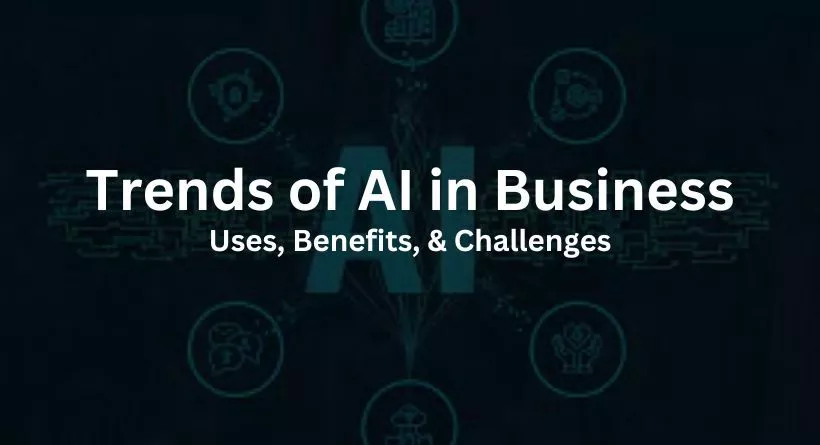
In today’s fast-paced digital landscape, Artificial Intelligence (AI) has emerged as a transformative force in the business world. This article delves into the various trends of AI in business, highlighting its uses, benefits, and challenges.
Artificial Intelligence, once the realm of science fiction, has become a critical asset for businesses across industries. As the technology continues to evolve, it’s essential to understand the trends, benefits, and challenges associated with its adoption in the business world.
The Versatile Uses of AI in Business
A New Era of Customer Service
One of the most significant impacts of AI in business is the transformation of customer service. AI-driven chatbots and virtual assistants have revolutionized the way companies interact with their customers. These systems offer round-the-clock support, answering queries, resolving issues, and even processing orders, all while enhancing the overall customer experience.
Enhanced Decision-Making
AI provides data-driven insights that enable businesses to make more informed decisions. Machine learning algorithms analyze vast datasets, helping organizations identify market trends, customer preferences, and operational inefficiencies. In turn, this leads to smarter strategic decisions and a more competitive edge.
Personalized Marketing
The era of one-size-fits-all marketing is over. AI allows businesses to create highly personalized marketing campaigns. By analyzing customer behavior and preferences, AI can recommend products, tailor content, and send targeted promotions. This results in improved customer engagement and higher conversion rates.
You may also like reading: How Artificial Intelligence is Changing the Future of Business
Reaping the Benefits of AI

Increased Efficiency and Productivity
Automation through AI reduces the need for repetitive and time-consuming tasks, allowing employees to focus on more creative and strategic activities. This increased efficiency not only saves time but also reduces operational costs.
Cost Reduction
AI-driven automation can significantly cut operational costs by minimizing errors, streamlining processes, and optimizing resource allocation. This is especially beneficial for small and medium-sized businesses looking to compete with larger players.
Competitive Edge
Businesses that embrace AI gain a competitive edge in the market. AI enhances the ability to predict customer behavior, respond to market shifts, and innovate rapidly. Staying ahead of the competition is crucial in today’s dynamic business environment.
Challenges in Implementing AI
Data Privacy and Security Concerns
The collection and utilization of vast amounts of data for AI can raise concerns about data privacy and security. Companies need robust cybersecurity measures to protect sensitive information and comply with data protection regulations.
Skill Gap
While AI offers remarkable opportunities, there is a shortage of skilled professionals capable of implementing and maintaining AI systems. Businesses need to invest in training and talent acquisition to bridge this skill gap effectively.
Integration Complexities
Integrating AI systems with existing infrastructure can be complex. Compatibility issues, data migration challenges, and the need for seamless interactions can create hurdles for businesses adopting AI.
AI in Different Business Sectors
AI is making a significant impact across various sectors:
Healthcare
AI assists in diagnosing diseases, managing patient records, and drug discovery, revolutionizing healthcare with improved accuracy and efficiency.
Finance
In the financial sector, AI is used for fraud detection, algorithmic trading, and personalized financial advice.
E-Commerce
E-commerce businesses use AI for product recommendations, inventory management, and customer support.
Manufacturing
AI enhances manufacturing processes by optimizing supply chains, predictive maintenance, and quality control.
Future Trends in AI

Natural Language Processing
AI’s ability to understand and generate human language is a growing trend, with applications in chatbots, language translation, and content generation.
AI in IoT
The integration of AI and the Internet of Things (IoT) is on the rise, enabling smart devices to make data-driven decisions independently.
AI Ethics and Bias Mitigation
Addressing ethical concerns and mitigating bias in AI algorithms will be a crucial focus for businesses to build trust with customers and regulators.
Conclusion
Artificial Intelligence is reshaping the business landscape. It offers a plethora of benefits, from improved customer service to data-driven decision-making, but it also presents challenges like data privacy and skill gaps. To thrive in this AI-driven world, businesses must adapt and stay ahead of the ever-evolving trends in AI.
FAQs
1. How can AI benefit small businesses?
AI can benefit small businesses by automating tasks, reducing operational costs, and enhancing customer service, providing them with tools to compete effectively in the market.
2. What are the main challenges in implementing AI in business?
The main challenges in implementing AI include data privacy and security concerns, skill gaps, and integration complexities with existing systems.
3. How is AI transforming the healthcare sector?
AI is transforming healthcare by improving disease diagnosis, streamlining patient records, and aiding in drug discovery, ultimately leading to better patient care.
4. What is the future of AI in business?
The future of AI in business lies in natural language processing, AI in IoT, and addressing ethical concerns and biases in AI algorithms.
5. How can businesses ensure AI is used ethically?
Businesses can ensure ethical AI use by transparently disclosing AI use, regularly auditing AI systems, and actively working to mitigate biases in AI algorithms.





